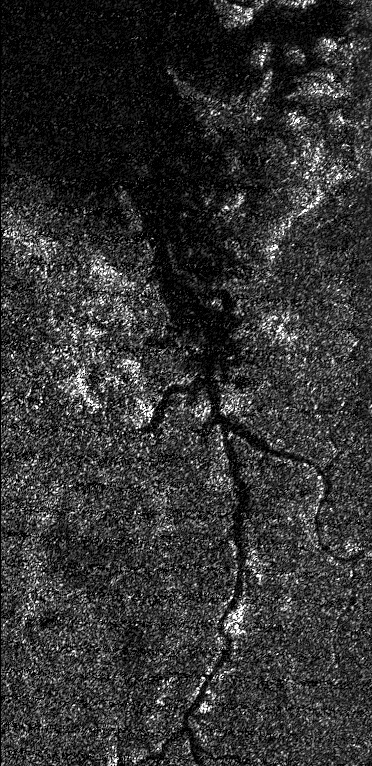The image show s what looks like a satellite picture of a river delta, complete with tributaries. It could be the Nile or the Amazon river systems as seen from space.
s what looks like a satellite picture of a river delta, complete with tributaries. It could be the Nile or the Amazon river systems as seen from space.
However, the image is not of an earthbound river at all. It’s a recently discovered river on Titan, Saturn’s largest moon. And, the river’s contents are not even water, but probably a mixture of liquid ethane and methane.
[div class=attrib]From NASA:[end-div]
This image from NASA’s Cassini spacecraft shows a vast river system on Saturn’s moon Titan. It is the first time images from space have revealed a river system so vast and in such high resolution anywhere other than Earth. The image was acquired on Sept. 26, 2012, on Cassini’s 87th close flyby of Titan. The river valley crosses Titan’s north polar region and runs into Ligeia Mare, one of the three great seas in the high northern latitudes of Saturn’s moon Titan. It stretches more than 200 miles (400 kilometers).
Scientists deduce that the river is filled with liquid because it appears dark along its entire extent in the high-resolution radar image, indicating a smooth surface. That liquid is presumably ethane mixed with methane, the former having been positively identified in 2008 by Cassini’s visual and infrared mapping spectrometer at the lake known as Ontario Lacus in Titan’s southern hemisphere. Though there are some short, local meanders, the relative straightness of the river valley suggests it follows the trace of at least one fault, similar to other large rivers running into the southern margin of Ligeia Mare (see PIA10008). Such faults may lead to the opening of basins and perhaps to the formation of the giant seas themselves.
North is toward the top of this image.
The Cassini-Huygens mission is a cooperative project of NASA, the European Space Agency and ASI, the Italian Space Agency. NASA’s Jet Propulsion Laboratory, a division of the California Institute of Technology in Pasadena, manages the mission for NASA’s Science Mission Directorate, Washington. The Cassini orbiter was designed, developed and assembled at JPL. The RADAR instrument was built by JPL and the Italian Space Agency, working with team members from the US and several European countries. JPL is a division of the California Institute of Technology in Pasadena.
[div class=attrib]Read the entire article following the jump.[end-div]
[div class=attrib]Image courtesy of NASA/JPL-Caltech/ASI.[end-div]
 The system of streams and tributaries that feeds the great Mississippi river is a complex interconnected web covering around half of the United States. A new mapping tool puts it all in one intricate chart.
The system of streams and tributaries that feeds the great Mississippi river is a complex interconnected web covering around half of the United States. A new mapping tool puts it all in one intricate chart.

 You will have heard of the River Thames, the famous swathe of grey that cuts a watery path through London. You may even have heard of several of London’s prominent canals, such as the Grand Union Canal and Regent’s Canal. But, you probably will not have heard of the mysterious River Fleet that meanders through eerie tunnels beneath the city.
You will have heard of the River Thames, the famous swathe of grey that cuts a watery path through London. You may even have heard of several of London’s prominent canals, such as the Grand Union Canal and Regent’s Canal. But, you probably will not have heard of the mysterious River Fleet that meanders through eerie tunnels beneath the city.